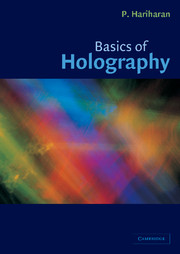Book contents
- Frontmatter
- Contents
- Preface
- 1 Holographic imaging
- 2 The reconstructed image
- 3 Thin and thick holograms
- 4 Light sources
- 5 The recording medium
- 6 Recording materials
- 7 Display holograms
- 8 Multicolor images
- 9 Copying holograms
- 10 Computer-generated holograms
- 11 Applications in imaging
- 12 Other applications
- 13 Holographic interferometry
- 14 Advanced techniques
- 15 Electronic techniques
- Appendix A Interference and coherence
- Appendix B Fourier transforms
- Appendix C Wave propagation
- Appendix D Speckle
- Bibliography
- Index
10 - Computer-generated holograms
Published online by Cambridge University Press: 06 July 2010
- Frontmatter
- Contents
- Preface
- 1 Holographic imaging
- 2 The reconstructed image
- 3 Thin and thick holograms
- 4 Light sources
- 5 The recording medium
- 6 Recording materials
- 7 Display holograms
- 8 Multicolor images
- 9 Copying holograms
- 10 Computer-generated holograms
- 11 Applications in imaging
- 12 Other applications
- 13 Holographic interferometry
- 14 Advanced techniques
- 15 Electronic techniques
- Appendix A Interference and coherence
- Appendix B Fourier transforms
- Appendix C Wave propagation
- Appendix D Speckle
- Bibliography
- Index
Summary
Computer-generated holograms can produce wavefronts with any prescribed amplitude and phase distribution and have, therefore, found many applications. The production of such holograms has been discussed by Lee [1978], Yaroslavskii and Merzlyakov [1980] and Dallas [1980], and essentially involves two steps.
The first step is to calculate the complex amplitude of the object wave at the hologram plane; for simplicity, this is usually taken to be the discrete Fourier transform (see Appendix B) of the complex amplitude at an N×N set of points in the object plane. The second step involves using the N×N computed values of the discrete Fourier transform to produce a transparency (the hologram) which reconstructs the object wave when it is suitably illuminated.
Two approaches have been followed for this purpose. In the first, which is analogous to off-axis holography, the complex amplitudes of a plane reference wave and the object wave, at each point in the hologram plane, are added, and the squared modulus of their sum is evaluated. These values are used to produce a transparency whose amplitude transmittance is real and positive everywhere.
An alternative is to produce a transparency that records both the amplitude and the phase of the object wave in the hologram plane. This transparency can be thought of as the superposition of two transparencies, one of constant thickness having a transmittance at each point proportional to the amplitude of the object wave, and the other with uniform transmittance but having thickness variations proportional to the phase of the object wave.
Information
- Type
- Chapter
- Information
- Basics of Holography , pp. 82 - 93Publisher: Cambridge University PressPrint publication year: 2002
Accessibility standard: Unknown
Why this information is here
This section outlines the accessibility features of this content - including support for screen readers, full keyboard navigation and high-contrast display options. This may not be relevant for you.Accessibility Information
- 1
- Cited by
